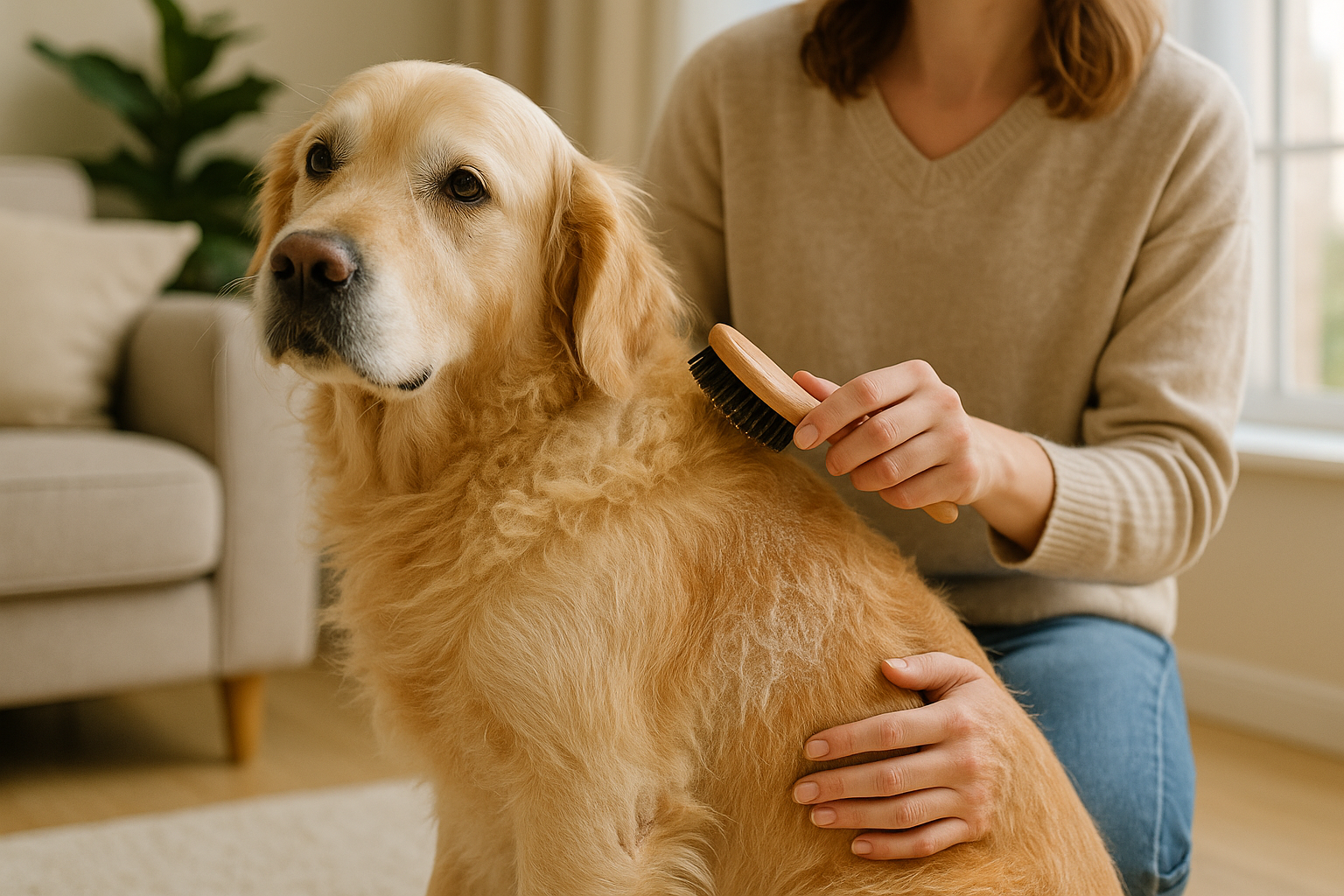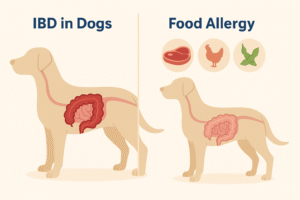Medical Disclaimer:
This article is for informational purposes only and does not substitute professional veterinary advice, diagnosis, or treatment. Always consult your veterinarian before making changes to your dog’s health regimen, especially if your pet is showing signs of illness or discomfort.
Table of Contents
Introduction
If your dog is constantly scratching, shedding dandruff-like flakes, or sporting rough, dull patches of coat, you’re not imagining things dog dry flaky skin is a common but frustrating issue. As a veterinarian, I’ve seen countless cases where pet parents are unsure whether the culprit is seasonal dryness, allergies, parasites, or something deeper like seborrhea or nutritional deficiency. The good news? Most cases are treatable once you identify the root cause.
In this guide, we’ll explore scientifically supported strategies to soothe and heal your dog’s skin from improving their diet to adjusting their grooming routine. Whether it’s a mild annoyance or a chronic condition, you’ll find proven ways to bring relief and restore your dog’s healthy, comfortable coat.
✅ Key Takeaways
- Dog dry flaky skin can stem from allergies, parasites, seborrhea, poor nutrition, or endocrine disorders.
- Veterinary diagnosis including skin scrapings, bloodwork, and allergy tests is crucial to guide effective treatment.
- Gentle, moisturizing shampoos and omega-rich supplements (like fish oil with EPA/DHA) support skin barrier repair.
- Environmental improvements humidifiers, clean bedding, and reduced allergens can dramatically reduce flare-ups.
- Managing seborrhea, infections, or autoimmune skin disease requires long-term, tailored plans in partnership with your vet.
With early action and consistent care, most dogs show visible improvement in skin and coat within 4–6 weeks.
What Causes Dog Dry Flaky Skin?
Also see: https://doglifeexpert.com/5-proven-dog-acupressure-points/
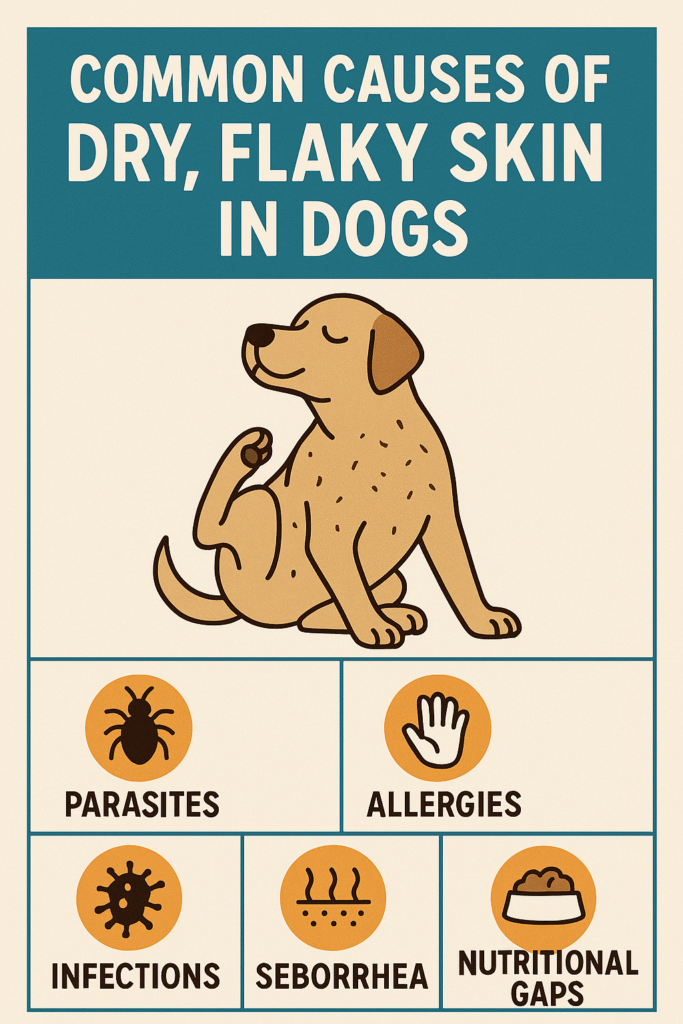
Parasitic Irritation
External parasites like cheyletiella (nicknamed “walking dandruff”), Demodex, and sarcoptic mange mites frequently cause dog dry flaky skin by inflaming the surface layer and triggering intense scratching. According to DVM360, these microscopic pests disrupt the skin’s protective barrier and often result in visible dandruff, hair loss, and secondary infections. Prompt veterinary identification through skin scrapings is essential.
Allergies & Atopic Dermatitis
Environmental allergens like pollen, mould, or dust mites can lead to atopic dermatitis, a chronic inflammatory skin disease that’s often inherited. Affected dogs commonly show dry, flaky skin, itchiness, and red, inflamed areas. Food allergies may also present similarly. As explained in PetMD, atopic dogs benefit from a combination of antihistamines, immunotherapy, and skin-supportive diets.
Infections: Bacterial or Fungal
Once the skin barrier is compromised, opportunistic infections most notably Staphylococcus pseudintermedius or Malassezia yeast can flourish. These infections worsen inflammation and create greasy flakes or pustules. According to the American Kennel Club, treatment typically involves topical antiseptics or prescribed oral antibiotics/antifungals.
Endocrine or Autoimmune Disorders
Underlying medical conditions like hypothyroidism, Cushing’s disease, or autoimmune skin disorders (e.g., lupus, pemphigus) may manifest with dog dry flaky skin, slow hair regrowth, or pigment changes. A comprehensive lab panel is needed to uncover these systemic issues. The Cornell Canine Health Center outlines diagnostic steps and cautions for immunosuppressive therapies.
Nutritional Deficiencies & Aging
Dogs lacking key nutrients especially vitamin A, biotin, zinc, riboflavin, copper, and omega fatty acids often show signs of flaky skin and dull coats. Aging dogs are particularly at risk as sebaceous gland output declines. Maintaining optimal skin health in older pets requires tailored nutrition with adequate fatty acids and trace minerals.
Seborrhea
Seborrhea sicca, the dry-flaky subtype, is characterized by scaling, skin debris, and brittle hair. It may be primary (genetic) in breeds like Cocker Spaniels or secondary to infection, endocrine disease, or environmental triggers. The Spruce Pets notes that treatment involves regular antiseborrheic bathing and dietary support.
Diagnosing the Root Cause
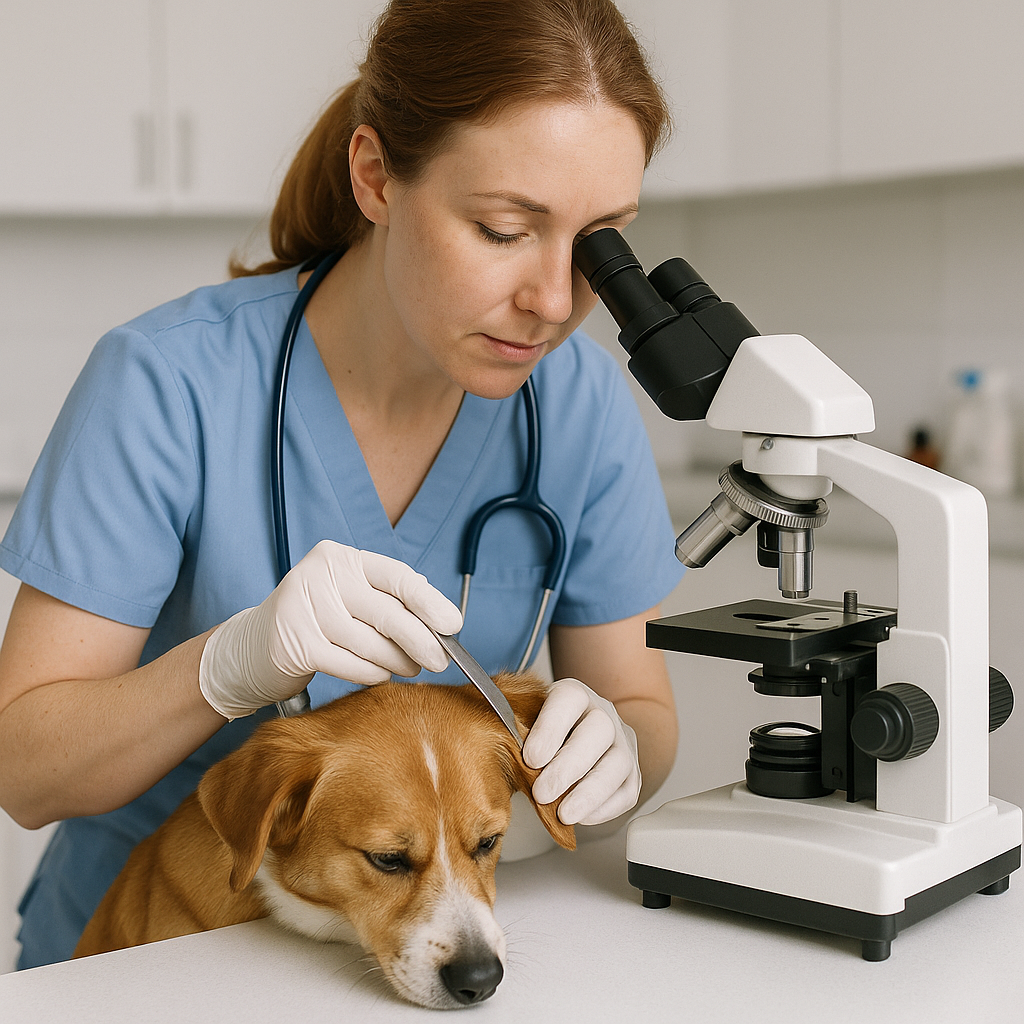
To effectively treat dog dry flaky skin, your veterinarian must first determine the underlying cause. While flaky skin might appear similar on the surface, the origins vary widely from parasites to autoimmune disease.
Veterinary Diagnostic Tools
When a dog presents with persistent dog dry flaky skin, your veterinarian’s priority is to determine the underlying cause, not just manage the symptoms. Multiple skin conditions parasites, allergies, endocrine disorders, or autoimmune diseases can look similar at first glance. Accurate, methodical diagnosis helps avoid unnecessary treatments and ensures lasting relief.
Physical Examination
A full-body skin and coat evaluation is the starting point. Your veterinarian will:
- Assess coat texture and hydration: Dry, brittle hair may point to nutritional or metabolic causes.
- Check for odour: A musty or yeasty smell may suggest Malassezia yeast overgrowth.
- Identify visible parasites, scales, or crusts.
- Examine hotspots or areas of hair loss (alopecia).
- Check the ears, armpits, groin, and paws common zones for allergic dermatitis and secondary infections.
A thorough exam may also reveal systemic signs like weight gain or lethargy that support hormonal causes of dog dry flaky skin.
Skin Scrapings and Tape Impressions
To check for external parasites, your vet may perform:
- Deep skin scrapings to identify burrowing mites like Demodex or scabies (Sarcoptes scabiei).
- Surface tape impressions to detect Cheyletiella (“walking dandruff”), bacteria, or fungal spores.
These methods are quick, affordable, and performed during the initial consult. DVM360 emphasizes that many mite infestations go undiagnosed without proper microscopy.
Cytology
Cytology involves taking a swab, tape strip, or impression smear from flaky or inflamed skin areas and examining it under a microscope. It helps detect:
- Bacterial overgrowth (e.g., Staphylococcus pseudintermedius)
- Fungal elements (yeast like Malassezia pachydermatis)
- Inflammatory cells that may suggest chronic allergic disease or autoimmune activity
This test is essential before prescribing antibiotics or antifungals for dog dry flaky skin.
Bloodwork and Endocrine Testing
If clinical signs suggest a systemic disorder, your vet may run:
- Complete blood count (CBC) and biochemistry panel: To check organ function and inflammation.
- Thyroid panel (T4, fT4, TSH): To screen for hypothyroidism, a common cause of thinning hair, dull coat, and flaky skin in middle-aged dogs.
- ACTH stimulation or dexamethasone suppression test: To diagnose Cushing’s disease, which can cause skin thinning, hair loss, and delayed wound healing.
These endocrine disorders often go unnoticed but are key contributors to dog dry flaky skin, especially in senior pets.
Allergy Testing
Dogs with seasonal or year-round itchiness and flaking may undergo:
- Serum allergy tests: Blood samples that screen for environmental allergens (pollen, mould, dust mites).
- Intradermal skin testing: Small allergen injections under the skin, typically done by veterinary dermatologists.
- Elimination diets: Feeding a limited-ingredient or hydrolyzed protein diet for 6–8 weeks to identify food-related allergies.
PetMD emphasizes the importance of allergy testing in dogs with recurring or unexplained flaky skin.
Skin Biopsy
If autoimmune diseases like pemphigus foliaceus or lupus are suspected, your vet may recommend a punch biopsy a small, full-thickness skin sample taken under local or general anesthesia.
- Biopsy offers definitive diagnosis, especially when symptoms are chronic, unusual, or resistant to treatment.
- According to Cornell University’s Riney Canine Health Center, biopsy is essential before starting immunosuppressive therapies like corticosteroids or cyclosporine.
Why It Matters
Misdiagnosis can lead to:
- Unnecessary or ineffective treatments
- Worsening of skin condition due to delayed proper care
- Increased cost over time
Correctly diagnosing dog dry flaky skin from the beginning not only improves outcomes it often prevents months of trial-and-error.
Treatment & Management Strategies
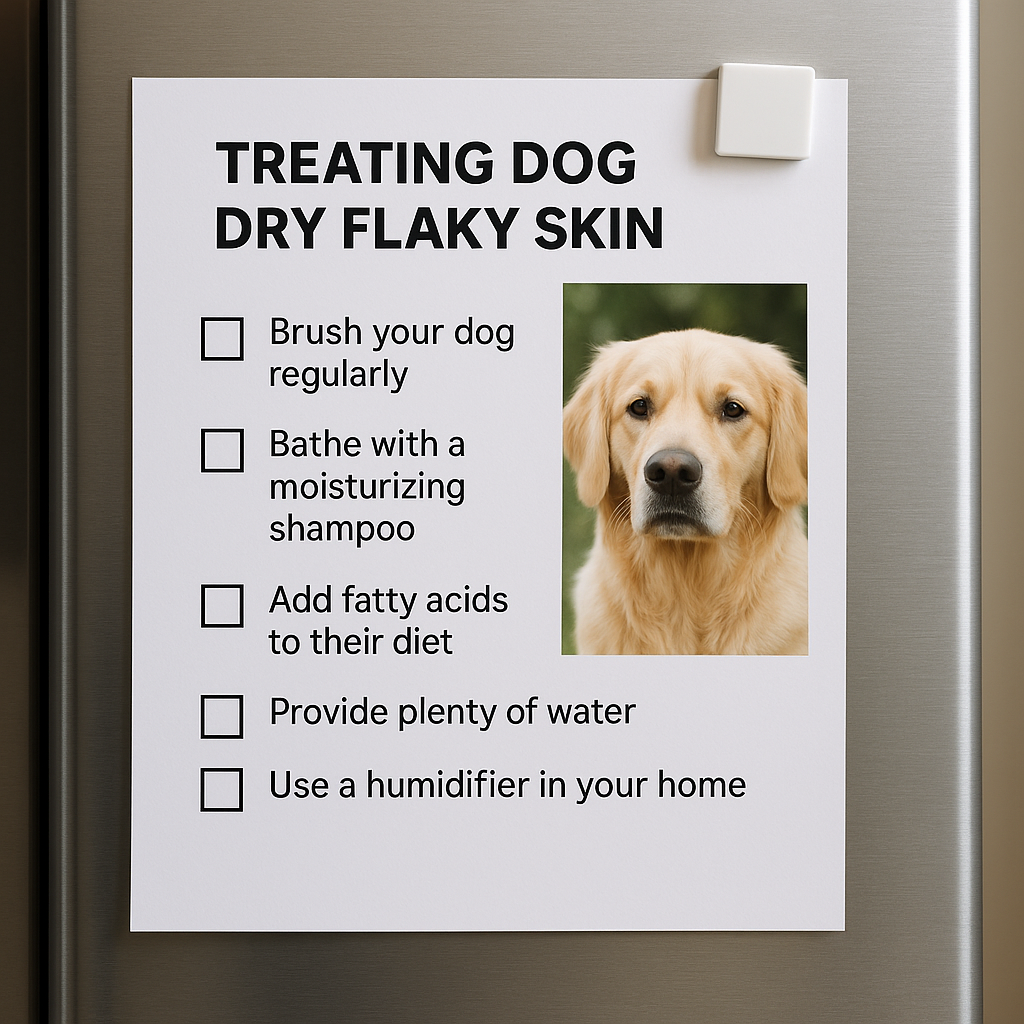
Effectively addressing dog dry flaky skin requires a multifaceted approach. Once the cause is identified, your veterinarian can tailor a combination of medical, nutritional, and environmental interventions.
Parasite Control
If mites or lice are the culprits, prescription antiparasitics such as selamectin, sarolaner, or lime sulfur dips may be necessary. Over-the-counter flea/tick preventives won’t eliminate mange. As noted in DVM360, follow-up skin scrapings help confirm eradication.
🐾 Tip: Disinfect grooming tools and wash bedding weekly to prevent re-infestation.
Allergy & Infection Management
Allergic dogs benefit from:
- Hypoallergenic diets (novel protein or hydrolyzed formulas)
- Immunotherapy (custom allergy shots or sublingual drops)
- Medications like oclacitinib (Apoquel®), lokivetmab (Cytopoint®), or corticosteroids
If infection is present, your vet may prescribe topical chlorhexidine, ketoconazole shampoos, or systemic antibiotics/antifungals as needed (American Kennel Club).
Gentle Grooming & Bathing
Harsh shampoos strip natural oils and worsen dog dry flaky skin. Instead, opt for:
- Colloidal oatmeal or ceramide-based moisturising shampoos
- Antiseborrheic products (e.g., salicylic acid, sulfur, coal tar)
- Oil soaks with mineral oil before bathing to loosen scales (Wikipedia – Sebaceous adenitis)
Limit baths to every 2–4 weeks unless directed by your vet.
Nutritional Support
Nutrition plays a foundational role in skin health, especially for dogs suffering from dog dry flaky skin. A complete, balanced diet is not just about meeting calorie needs it’s about providing the skin with the structural and anti-inflammatory nutrients it needs to function properly as a barrier.
Essential Fatty Acids: Omega-3 and Omega-6
Omega-3 fatty acids especially eicosapentaenoic acid (EPA) and docosahexaenoic acid (DHA) have potent anti-inflammatory properties. Derived primarily from cold-water fish oil, these compounds help reduce allergic responses and modulate the immune system. Supplementing with omega-3s has been shown to:
- Decrease skin redness and irritation
- Improve coat sheen and softness
- Reduce itch-related behaviours in allergic dogs
- Support repair of damaged skin tissue
Omega-6 fatty acids, such as linoleic acid, are equally essential. They help form the skin’s lipid barrier, which prevents moisture loss. Dogs deficient in linoleic acid often develop dull coats, increased shedding, and flaky skin.
Micronutrients: The Skin-Healing Team
A variety of trace minerals and vitamins work together to support epidermal health. Deficiencies in these nutrients can directly cause or exacerbate dog dry flaky skin:
- Zinc: Crucial for collagen production and wound healing. Zinc-responsive dermatosis often seen in breeds like Huskies leads to thick crusts and dry, flaky skin if untreated.
- Biotin (Vitamin B7): Vital for keratin production. Biotin deficiency may cause dermatitis, alopecia, and excessive scaling. It’s particularly effective when combined with zinc and fish oil in supplements.
- Vitamin A: Regulates the turnover of skin cells (keratinization). Low levels can cause follicular plugging, hyperkeratosis, and scaling.
- Vitamin E: An antioxidant that protects skin lipids from oxidative damage. It supports immune function and helps reduce inflammation in chronic skin conditions.
- Riboflavin (Vitamin B2): Supports tissue repair and mucosal health. A deficiency may result in greasy, scaly skin or secondary infections.
- Copper: Plays a role in melanin synthesis and enzyme function. Low copper can impact pigmentation and coat texture.
How to Ensure Optimal Intake
To correct or prevent nutritional causes of dog dry flaky skin, follow these tips:
- Choose a veterinary-formulated diet labelled as “complete and balanced” by AAFCO for your dog’s life stage.
- Consider adding a high-quality skin supplement with fish oil (EPA/DHA), zinc, biotin, and vitamin E under veterinary supervision.
- Be cautious with home-cooked diets unless formulated by a board-certified veterinary nutritionist.
- Monitor for signs of improvement typically visible within 4–6 weeks if dietary deficiency was a contributing factor.
Sample Owner Guidelines:
- Add fish oil supplements (EPA/DHA) with vitamin E under vet guidance
- Choose AAFCO-certified diets that meet life-stage requirements
- Add biotin if deficiency is suspected many skin-specific formulas include it
Environmental Enhancements
Indoor heating during winter worsens dog dry flaky skin by drying the air. Try:
- Using a humidifier near your dog’s sleeping area
- Washing bedding weekly with fragrance-free detergent
- Minimizing airborne allergens (dust, pollen) with HEPA filters
According to PetMD, even small changes in environment can yield noticeable improvements.
Managing Seborrhea
Dogs with seborrhea benefit from:
- Routine medicated baths (twice weekly at first, then taper)
- Oil soaks pre-bath for thick scaling
- Supplementation with EFAs and fat-soluble vitamins
Some breeds may need lifelong management, but many cases improve with consistent care (The Spruce Pets).
🕔 5-Minute Home Checklist for Dog Dry Flaky Skin
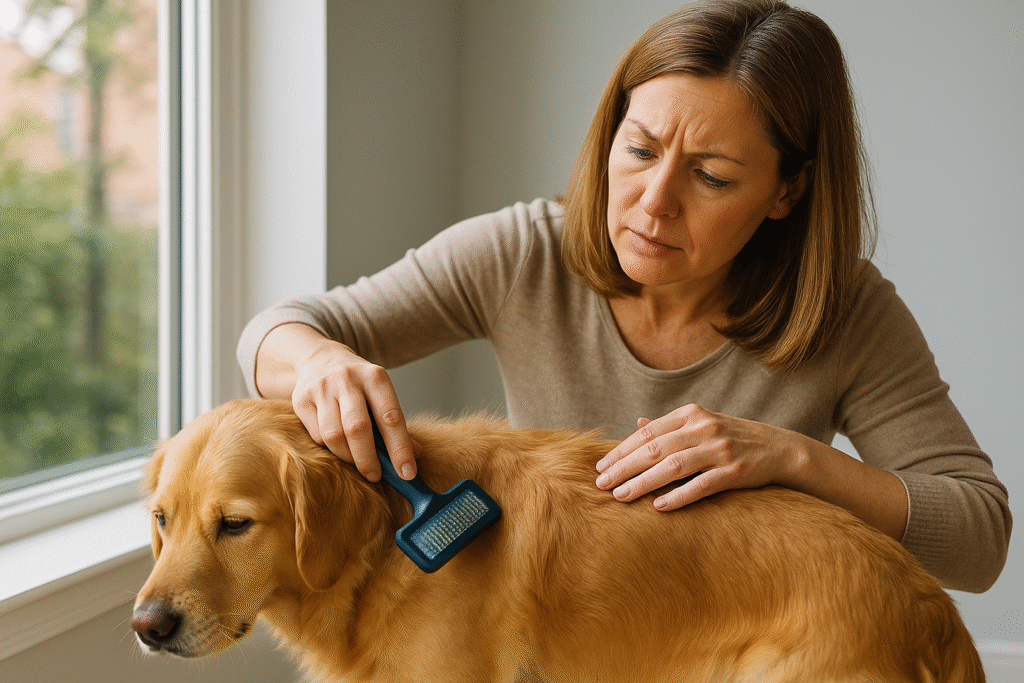
Before calling your vet, here’s a quick checklist you can run through at home. It helps you spot patterns, identify potential triggers, and prep for your veterinary visit.
At-Home Observations:
- Check coat texture: Is it dry, dull, brittle, or oily?
- Part the fur: Look for white flakes, redness, crusts, or sores.
- Smell the skin: Musty or greasy odour could indicate infection.
- Note itchiness: Is your dog scratching more than usual?
- Observe changes: Has the weather shifted recently (e.g., dry winter air)?
- Check diet: Has there been a recent food switch or missed supplements?
- Look at other pets: Are they also itchy or flaky?
By jotting down these notes, you’ll help your vet rule out environmental vs. internal causes more efficiently. This saves time and ensures treatment for dog dry flaky skin is targeted from the start.
Typical Canadian Cost Estimates
Managing dog dry flaky skin in Canada can range from minimal home adjustments to more involved medical workups and treatments. Here’s a general cost breakdown (in CAD):
| Service or Product | Estimated Cost |
|---|---|
| Veterinary consult + skin exam | $90 – $150 |
| Skin scrapings/cytology | $45 – $80 |
| Allergy testing (blood/intradermal) | $300 – $600 |
| Skin biopsy (with lab fees) | $250 – $450 |
| Prescription antiparasitics (monthly) | $15 – $60 |
| Medicated shampoos (250 mL bottle) | $25 – $40 |
| Fish oil supplements (30-day supply) | $20 – $60 |
| Hypoallergenic or prescription diet (monthly) | $90 – $150 |
| Cytopoint or Apoquel (monthly) | $120 – $200 |
| Humidifier for indoor use | $40 – $120 (one-time) |
Tip: Ask your vet about rebate programs for supplements and prescriptions.
Prices vary by province, veterinary clinic, and product brand. Pet insurance may cover diagnostic testing and chronic skin conditions, depending on your policy.
Step-by-Step Care Plan
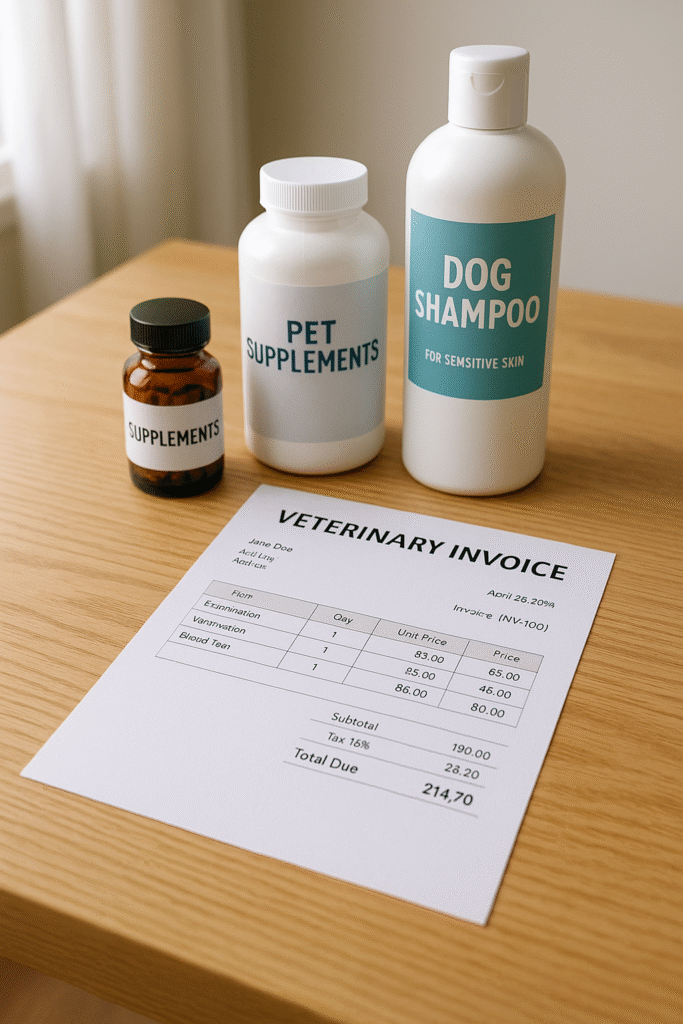
A structured approach helps you stay on top of your dog’s recovery. Here’s a simplified timeline and checklist for managing dog dry flaky skin effectively:
| Step | Action |
|---|---|
| 1️⃣ | Book a vet appointment: Full exam, skin scrapings, bloodwork if needed. |
| 2️⃣ | Treat parasites or infections promptly using prescribed medications. |
| 3️⃣ | Implement dietary changes or switch to a hypoallergenic diet if advised. |
| 4️⃣ | Begin a supplement routine with omega-3, biotin, vitamin E, and zinc. |
| 5️⃣ | Use gentle, moisturizing shampoos every 2–4 weeks. |
| 6️⃣ | Add a humidifier indoors, and clean bedding weekly. |
| 7️⃣ | Track progress: Note coat quality, flaking, and scratching weekly. |
| 8️⃣ | Recheck with your vet in 4–6 weeks if no significant improvement. |
Keep a photo log or journal it’s easier to show your vet subtle changes over time.
Real-World Application for Dog Owners
Helping your pet recover from dog dry flaky skin isn’t about perfection it’s about progress. Many improvements come from consistency and tracking the little wins.
Here’s What You Can Do:
- Document symptoms: Use your phone to snap weekly photos of flaking or irritated areas.
- Stick with supplements: Omega-3s and biotin often take 4–6 weeks to show visible coat changes.
- Watch behaviour: Less scratching, better sleep, and happier play are great signs of healing.
- Don’t skip vet check-ins: Rechecks ensure you’re not missing a hidden infection or endocrine disorder.
- Celebrate progress: A shinier coat, fewer flakes, or just more tail-wagging comfort is a big win.
One of my own patients, a senior Labrador named Moose, struggled for months with chronic flaking and itching. With a switch to a fish-based diet, a humidifier in his favourite nap spot, and twice-weekly gentle baths, he was back to his glossy self within eight weeks.
Every dog is different but with the right plan, most cases of dog dry flaky skin can be dramatically improved.
Notes & Caveats
While most cases of dog dry flaky skin are treatable, it’s important to understand a few limitations and risks.
- Autoimmune conditions like pemphigus or lupus require a biopsy for accurate diagnosis. These diseases may need long-term immunosuppressive therapy and cannot be diagnosed based on appearance alone (Cornell Vet Center).
- Supplements aren’t magic pills: While omega fatty acids, biotin, and zinc support healing, they can’t reverse genetic skin disorders like primary seborrhea or sebaceous adenitis (Wikipedia – Sebaceous adenitis).
- Overbathing worsens dryness: Even the best shampoo, if used too often, can strip oils. Follow your vet’s instructions on bath frequency.
- Always vet-check before supplementing: Especially for dogs with underlying kidney, liver, or endocrine conditions, some supplements may be contraindicated.
- Avoid trial-and-error: Self-diagnosing can delay proper care. Professional veterinary diagnosis remains key.
Treating dog dry flaky skin is a process not a one-size-fits-all fix.
Conclusion
Dog dry flaky skin is more than a cosmetic issue it can signal deeper health imbalances that deserve attention. Whether it’s caused by parasites, allergies, infections, seborrhea, or nutritional gaps, the key to healing lies in an accurate diagnosis and a well-rounded care plan.
From my experience as a veterinarian, the most successful outcomes happen when pet parents commit to both short-term treatment and long-term skin support. That means regular grooming, tailored diets, environmental improvements, and follow-up veterinary care.
While results can take several weeks, many dogs show visible relief with just a few small changes. The dog dry flaky skin fades and lessen. The coat begins to shine again. And most importantly, your dog feels more comfortable in their own skin.

